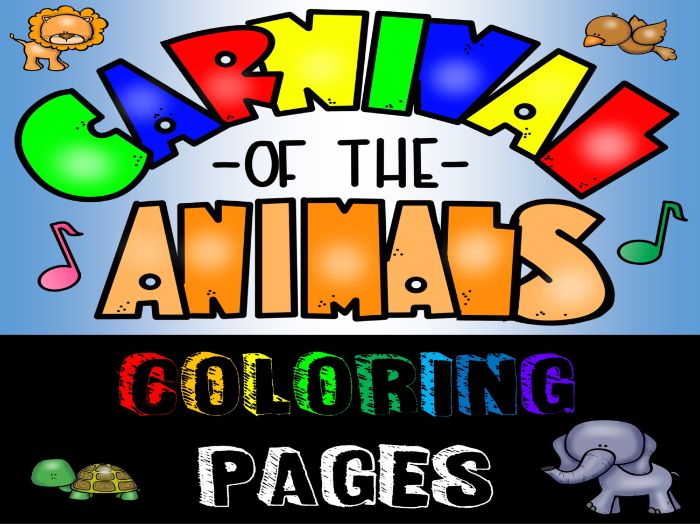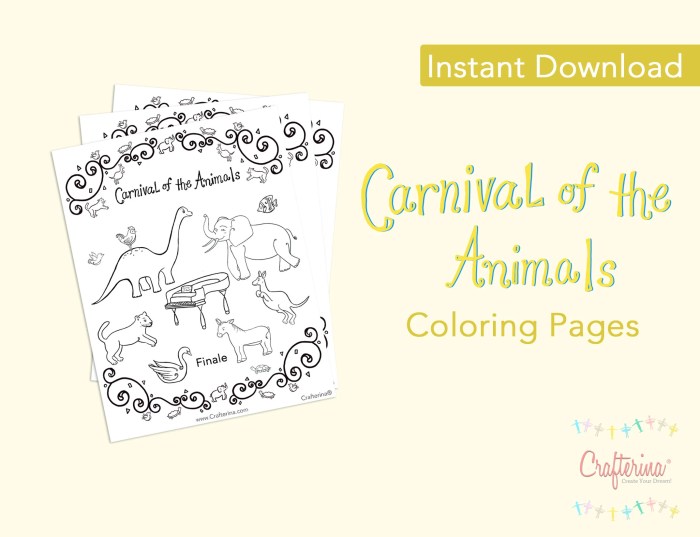Artistic Styles and Techniques in “Carnival of the Animals” Coloring Pages

Carnival of the animals coloring pages – The artistry applied to “Carnival of the Animals” coloring pages offers a diverse range of creative expression, catering to various skill levels and aesthetic preferences. The choice of style significantly impacts the final product, influencing both the coloring experience and the overall visual appeal.
Artistic Styles Employed
Different artistic styles lend themselves uniquely to the whimsical nature of Saint-Saëns’ composition. Watercolor styles, for example, offer a soft, dreamlike quality, ideal for capturing the delicate movements of the swans or the ethereal beauty of the aquarium. Pencil sketches, conversely, provide a more direct and intimate approach, allowing for fine detail and expressive linework to showcase the character of each animal.
Ink illustrations, with their bold lines and stark contrasts, create a more dramatic and sophisticated effect, perfectly suited to the energetic movements of the kangaroos or the majestic presence of the lion. These are just a few examples of the many artistic styles that can be successfully applied.
Color Palettes and Their Impact
The selection of a color palette is crucial in shaping the mood and atmosphere of the finished coloring page. A vibrant, saturated palette can bring energy and excitement, reflecting the lively nature of the carnival. Conversely, a more muted or pastel palette can evoke a sense of tranquility and calm. Consider a page depicting the elephants; a warm palette of browns, grays, and muted oranges might evoke a sense of grounded strength, while a cool palette of blues and greens could suggest a more peaceful and serene atmosphere.
Carnival of the Animals coloring pages offer a delightful way to engage with Saint-Saëns’ whimsical composition. The vibrant depictions of the animals often lend themselves to a broader exploration of animal imagery, leading you to resources like animal print coloring pages for further creative fun. Returning to the Carnival theme, remember to consider the individual personalities of each animal while coloring, bringing their unique charm to life.
The choice of color directly influences the viewer’s emotional response.
Levels of Detail in Coloring Pages
The level of detail in “Carnival of the Animals” coloring pages ranges significantly. Simple designs, often featuring bold Artikels and minimal internal detail, are ideal for younger children or those seeking a quick and relaxing activity. These designs focus on clear shapes and easily identifiable animals. Intricate designs, on the other hand, boast highly detailed linework, complex patterns, and subtle shading, providing a greater challenge for experienced colorists and allowing for a more nuanced and visually rich final product.
These intricate pages might feature textured fur, detailed feathers, or intricate backgrounds, offering a rewarding coloring experience.
Comparison of Coloring Page Styles
The following table compares three distinct styles of “Carnival of the Animals” coloring pages:
| Style | Complexity | Target Audience | Example Description |
|---|---|---|---|
| Simple Line Art | Low | Young Children (Ages 3-6) | Bold black Artikels of simplified animal shapes, minimal internal detail. Large areas for easy coloring. |
| Detailed Pencil Sketch | Medium | Older Children & Teens (Ages 7-15) | Fine lines defining muscle structure, fur texture, and facial features. Includes shading suggestions for depth. |
| Intricate Watercolor Design | High | Adults & Advanced Colorists (Ages 16+) | Complex patterns within the animal forms, incorporating intricate floral or geometric elements. Requires precise coloring and blending techniques. |
Educational Value and Applications of “Carnival of the Animals” Coloring Pages: Carnival Of The Animals Coloring Pages

“Carnival of the Animals” coloring pages offer a unique blend of artistic expression and educational enrichment, providing children with a fun and engaging way to learn about the natural world and develop essential skills. These pages, featuring Saint-Saëns’ whimsical musical depictions of various animals, transform a simple coloring activity into a multi-faceted learning experience.These coloring pages serve as a valuable tool for teaching children about diverse animal species.
Each animal depicted, whether it be the majestic elephant, the graceful swan, or the playful monkey, presents an opportunity to discuss their unique characteristics, habitats, and behaviors. Children can learn about different animal classifications, geographical locations, and even conservation efforts related to specific species. The visual representation paired with the accompanying music enhances the learning process, creating a memorable and holistic experience.
Developing Fine Motor Skills and Hand-Eye Coordination
The act of coloring itself contributes significantly to the development of fine motor skills and hand-eye coordination. The precise movements required to stay within the lines, control the pressure of the coloring tool, and blend colors effectively strengthens small muscles in the hands and fingers. This improved dexterity is crucial for later writing and other fine motor tasks.
The intricate details within some animal designs present a greater challenge, further refining these skills and encouraging perseverance. Children will naturally develop better control and precision through repeated practice.
Classroom and Homeschooling Applications
“Carnival of the Animals” coloring pages can easily be integrated into various classroom and homeschooling activities. They can be used as a reward system, a quiet activity during downtime, or as a supplement to a broader unit on animals, music, or art. Teachers could assign specific animals for children to color, encouraging research and presentation on the chosen creature.
A collaborative project could involve each child coloring a different animal, then assembling the finished pages to create a class-wide “Carnival of the Animals” display. The pages also lend themselves well to cross-curricular projects, combining art, music, and science.
Lesson Plan: Integrating Coloring Pages with Music Appreciation, Carnival of the animals coloring pages
This lesson plan combines the coloring pages with Saint-Saëns’ “Carnival of the Animals” suite.First, introduce the children to the musical piece, highlighting the distinct musical character assigned to each animal. Play a section of the music, and then show the corresponding coloring page. Discuss the animal’s characteristics and how the music reflects its nature. For instance, the “Aquarium” movement’s gentle, flowing melody reflects the serene underwater world.
Next, the children color the page, focusing on capturing the animal’s essence. Finally, have the children share their finished artwork and discuss their interpretation of both the music and the animal’s portrayal. This approach fosters a deeper understanding and appreciation of both art and music. This multi-sensory approach enhances memory retention and promotes a deeper engagement with the subject matter.
General Inquiries
Where can I find free Carnival of the Animals coloring pages?
Many websites offer free printable versions. A quick Google search should yield plenty of results!
Are these coloring pages suitable for adults?
Absolutely! The intricate designs can be a relaxing and therapeutic activity for adults too.
What kind of paper is best for these coloring pages?
Heavier weight paper (like cardstock) is ideal to prevent bleed-through, especially with markers or watercolors.
Can I sell coloring pages I’ve created based on Carnival of the Animals?
Probably not, unless you obtain the necessary licenses. It’s best to check copyright laws before doing so.
